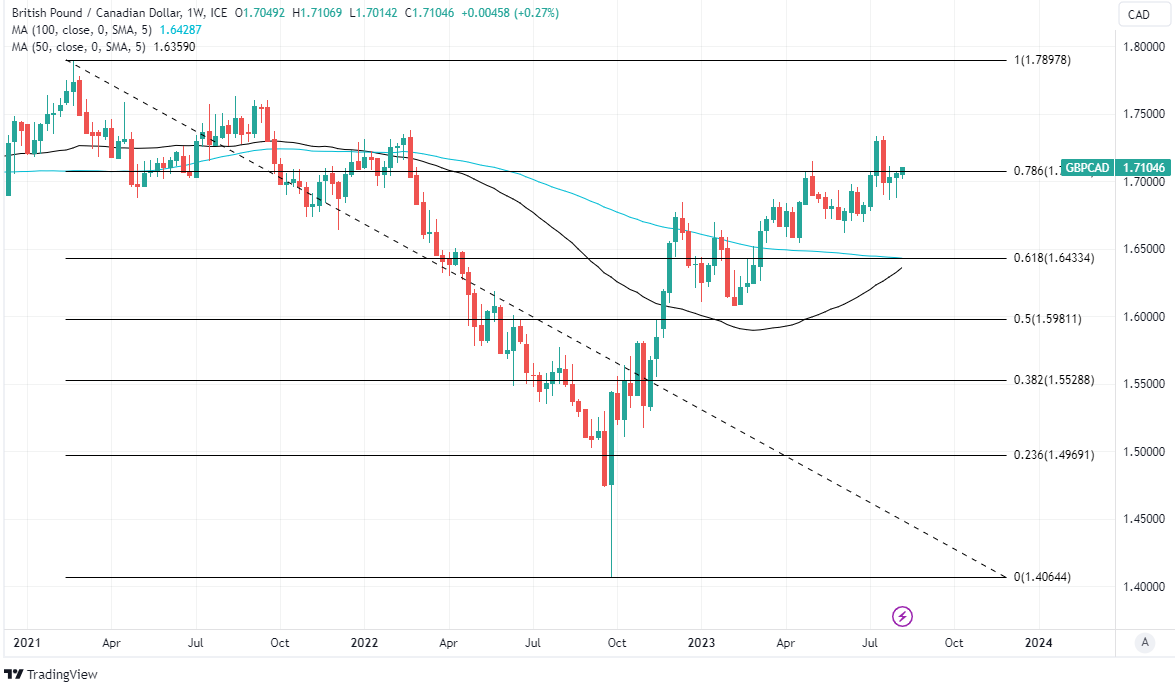Buoyant Pound to Canadian Rate Susceptible to Corrective Setbacks
- Written by: James Skinner
-
- GBP/CAD supported by key averages near 1.69
- Potential scope for short-term foray above 1.71
- Risk of setback if UK’s GDP data underwhelms

Image © Adobe Stock
The Pound to Canadian Dollar exchange rate climbed back to within arm’s reach of 2023 highs early in the new week but while it could remain buoyant in the short-term there is also a risk of corrective losses for Sterling if official data reveals any sign of Bank of England (BoE) interest rate taking its toll on the UK economy.
Sterling was a middle-ranked runner within the G10 grouping of major currencies for the week to Tuesday but still managed to edge higher against the Canadian Dollar for the period after North American currencies were swept lower in the market response to employment figures out last Friday.
“Job growth was largely flat in July, but controlling for a boost to the Canadian population, labour markets softened more significantly under the surface,” writes Carrie Freestone, an economist at RBC Capital Markets, in a review of Friday’s report.
Losses for North American currencies have helped lift GBP/CAD back above 1.70 after Statistics Canada said employment fell slightly in July and that unemployment edged higher when measured as a percentage of the labour force as well as when counting the number of individuals meeting the official definition of unemployed.
Canadian Dollar losses and the rally in GBP/CAD came alongside and may have even been aided by widespread declines in the U.S. Dollar pairs after July’s non-farm payrolls report also highlighted moderating employment growth in the U.S. last month.

Above: Pound to Canadian Dollar rate shown at daily intervals with selected moving averages and USD/CAD.
“Although unexpected, July's job loss should not come as a total surprise, as it follows an unsustainable gain of 60,000 the previous month,” says Matthieu Arseneau, deputy chief economist at National Bank of Canada Financial Markets.
“While it's too early to say that the Canadian labour market is in poor health, a number of factors point to a less than rosy picture. The first drop in private-sector employment in ten months suggests that weakening profits are beginning to weigh on job creation,” he adds.
Softening the growth of labour markets in order to moderate workforce earnings growth has been one key goal and means to an end for both the Bank of Canada (BoC) and Federal Reserve (Fed) as each have sought to use interest rates in order to bring inflation back to targeted levels.
But while there has been little softening of pay pressures so far, growth in both labour markets has moderated in recent months while inflation rates have also fallen, leading financial markets and forecasters to contemplate whether interest rates have peaked in North America.
“The market is pricing in an additional 25bp hike by the end of 2023,” says Jane Foley, head of FX strategy at Rabobank.
Recent losses for North American currencies have been supportive of GBP/CAD but the latter may also be sensitive this week to the outcome and implications of Thursday’s U.S. inflation figures for July and Friday’s release of UK economic growth numbers for June and the second quarter.
Above: Quantitative model estimates of possible trading ranges for the week ahead. Source: Pound Sterling Live.
“The US inflation data is expected to reflect a modest re-acceleration in prices, with a 0.2% M/M increase lifting the Y/Y clip to 3.2%, from June’s 3.0%. A fair bit of the recent improvement in inflation can be attributed to base effects, which are now diminishing,” writes Shaun Osbourne, chief FX strategist at Scotiabank, in a Friday research briefing.
Any undershoot of economist forecasts for the U.S. inflation rates would likely act as a further headwind for the U.S. Dollar and potentially also the Canadian Dollar, making such an outcome another possible tailwind for GBP/CAD, though the days ahead are not without risk for Sterling and particularly in light of the GDP data out on Friday.
The economist consensus is for GDP to have grown 0.2% in June to sit unchanged for the second quarter with this zero growth outcome following a 0.1% increase in the prior quarter, while leaving the economy in a potentially precarious position as the impact of recent increases in the Bank of England Bank Rate are increasingly felt.
“We judge that output was depressed by about 0.1 percentage points in May by the extra public holiday for the King’s coronation,” says Samuel Tombs, chief UK economist at Pantheon Macroeconomics, who forecasts a pick-up in UK economic growth over the remainder of the year.
“The boost to output in the consumer services sectors from the resulting increase in leisure time did not offset all of the hit to production across the rest of the economy from the lost working day. So GDP probably would have increased by 0.1% month-to-month in June, even if the economy were fundamentally stagnant,” he adds.

Above: Pound to Canadian Dollar rate shown at weekly intervals with Fibonacci retracements of 2021 fall indicating possible areas of technical resistance for Sterling.







